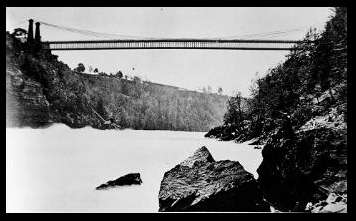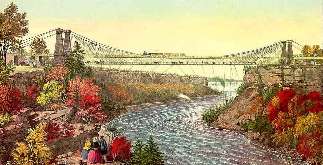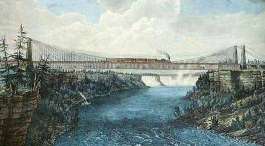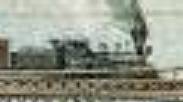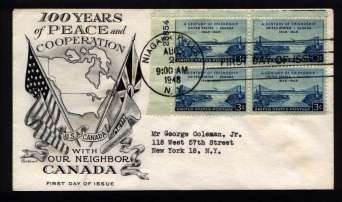
|
<<<< |

|
>>>> |

|

TRAINS ON U. S. STAMPS
and POSTAL STATIONERY
page 3c

Embossed postcard with train image - 20th Century Limited |
3¢ UNITED STATES-CANADA FRIENDSHIP ISSUE - Aug 2, 1948
This stamp shows a steam locomotive and passenger cars on the Niagara Railway Suspension Bridge over the Niagara River, joining the US and Canada. At the scale of the stamp I think that's all one can say about the train. The stamp was issued "to commemorate a Century of Friendship between the US and Canada", but I had a heck of a time determining exactly what event occurred in 1848 to begin that history. Neither Scott nor the USPS "Postal Service Guide to U.S. Stamps" was any help - both just say this is the US-Canada Friendship Issue. Nor could I find philatelic references for this stamp in the manner of Brookman and Johl, to cite the traditional sources, or George Amick, to cite their modern successor.
(The period from 1946, when Johl's work ceased, until 1983, when Amick's began, seems sadly barren
I was able to determine, however (thanks to this Wikipedia page) that the bridge shown on the stamp was one built in 1855, and in use from 1855 to around 1880. It was designed and constructed by the famous engineer/bridge builder John A. Roebling, who later designed the Brooklyn Bridge. I deduce this from the pairs of large stone towers holding up the suspension cables at each end, clearly visible in both the stamp and website images of the bridge. The bridge linked Niagara Falls, NY and Niagara Falls, Ontario, and was revolutionary in its time, hailed as one of the engineering marvels of the century at its completion. With two decks, the lower for pedestrians and horse-drawn carriages, the upper for railway traffic, it carried trains of the Grand Trunk Railroad, the New York Central, and of the Great Western Railroad between the US and Canada. So fine, I had identified the subject of the image on the stamp, but still had no clue why it was issued. I dragged out my old encyclopedia (don't need a new one to learn about events a century ago, right?) and read the article on Canadian history, but could find no mention of a significant event in 1848 - indeed, Canada did not become a self- governing dominion of the British Empire until 1867. Finally, in desperation, I looked at my old H. E. Harris U.S Stamp Album, which I've been meaning for years to give to some deserving young collector (but then things like this keep happening!) - and the caption under Scott 961 reads "This stamp marked a century since the Niagara River was first spanned by a bridge, and 100 peaceful years along the mutually unguarded border". Another website includes the following: Case closed. Eventually I looked where I should have looked to begin with, my FDC collection for this issue, and found the one below, with text telling us exactly why the stamp was issued, and actually showing that first bridge - why the USPOD chose to show a later bridge instead, especially considering the first bridge did not carry rail traffic, is a question on which we can only speculate. (Click on the image to enlarge) How about the source of the stamp's image? In researching one of the other stamps on these pages, I found the wonderful site of The Central Pacific Railroad Photographic History Museum, which you must visit, it has a fabulous collection of railroad prints, including a classic Currier & Ives showing the Niagara Railway Suspension Bridge. I obtained my own copy of that print, and offer it here below, cropped to show just the bridge:
I find particularly interesting the cables running from the lower deck of the bridge to anchors in the river banks below. The text about the earlier bridge on the site I mentioned at the beginning of this section talks about the fierce winds in the gorge, and the swaying of the previous bridge, so apparently Roebling added these to stabilize his design further. Yes, this page - discusses that very issue.
However, while that is a very nice Currier and Ives print, clearly it is NOT the same image as the one on the stamp. Looking further, at another website, I found the image below, which clearly IS the source of the US stamp design. It is an engraving by D L Glover, from an original painting by Ferdinand Richardt, published in New York in 1855 by H Peters.
Click on the small version above for a medium-scale enlargement, or click here for a high-resolution version of the image. It's 150Kb, but worth the wait, as there is an amazing amount of detail in the engraving - you can actually make out people walking on the lower level. Note how dramatically the scale of the train in relation to the bridge differs between this and the C&I print. Which artist took such license? The text (not shown) beneath the Peters image says that the span of the bridge between the towers was 800 feet. From that figure and measurements of the images, the steam locomotive plus tender on the Peters image would have been about 54 feet long, while locomotive plus tender on the C&I image would have been about 31 feet. The latter is a more realistic figure for the period, so I conclude the Currier and Ives image is the more realistic of the two. Richardt apparently exaggerated the size of his train so he could show more detail - here is an enlargement from his image:
I think it's safe to say it's an American-type 4-4-0, but beyond that I cannot identify it - can you? There were over 113 Million copies of this stamp printed, and many were saved, so its value is still basically the face value of 3 - I buy full sheets at close to face for use on my mail now and then. There are no known errors or plate varieties.
Above is a scan of one of the essays for this stamp, a proposed design that was rejected. Below are the two covers Dorothy Knapp created for this stamp, her commercial (Fleetwood) version on the left, and her personal version on the right. With no train in her image, these are not among my favorites, either of hers, or for the stamp, but it's interesting that they are so similar. Indeed, since she did not sign her Fleetwood cachet, we might not know it was hers, were it not for its similarity to her private one. I get the impression the topic did not inspire her. For more about the bridge on this stamp - and its predecessors - here is another CJRRU member's article |
|||||
US TRAINS
|
Send feedback to the webmaster: CLICK HERE
Revised -- 12/23/2004

